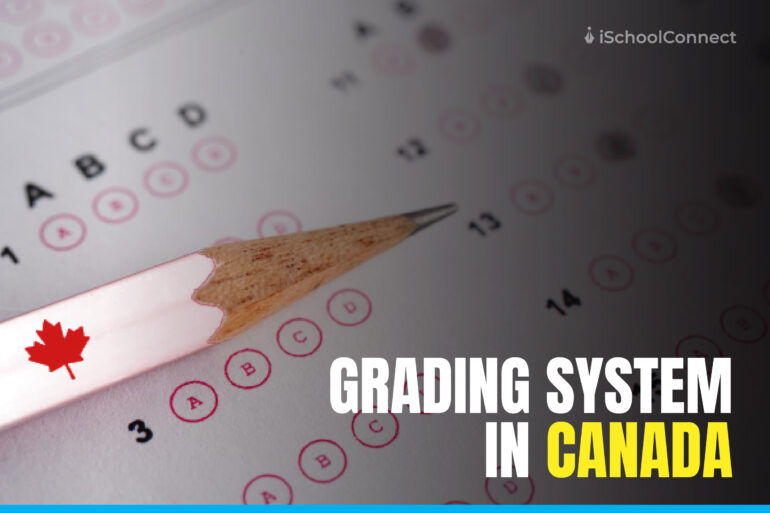Table of Contents
Canada is a top destination for students seeking higher education due to its exceptional education system. A crucial part of this system is the Canadian grading system, which is used to evaluate students’ academic performance. Whether you’re planning to study in Canada or are simply curious about its educational framework, understanding the Canadian grading system sedulously is essential.
Canadian Grading System
The Canadian grading system is a standardized method used across various levels of education, from elementary schools to universities. While there are slight variations by province and institution, the grading structure generally follows a similar pattern, utilizing letter grades and corresponding percentage scores.
- Grading System in Canadian Universities
At the university level, the academic grading system in Canada typically uses letter grades ranging from A+ (excellent) to F (fail). Each grade is associated with a specific percentage range, such as an A+ representing 90-100% and a B usually representing 70-79%. This grading structure allows for consistent evaluation and comparison of student performance across different institutions in Canada.
- Steps to Calculate GPA in Canada
Understanding how to calculate the Grade Point Average (GPA) in Canada is of utmost importance for students to check if they are eligible to apply or not.
- Assigning Grade Point Values: Each letter grade is assigned a corresponding grade point value, which may slightly vary between institutions.
- Calculating Credit Hours: Each course is assigned a specific credit value, representing the number of instructional hours per week.
- Multiplying Grades by Credit Hours: For each course, multiply the grade point value by the credit hours to calculate the weighted grade points.
- Summing Weighted Grade Points: Add up all the weighted grade points across all courses.
- Calculating GPA: Divide the sum of the weighted grade points by the total credit hours attempted.
Final GPA = GPA Value x Credit Hours
GPA Assessment in Canada
The GPA in Canada is assessed as follows:
Above 4.0: Excellent
Above 3.5: Very Good
Above 3.0: Good
Above 2.5: Satisfactory
Below 2.5: Needs Improvement
Most Canadian universities require a minimum GPA of 2.5 to pass, nonetheless it is always advisable to visit the university website and check the specific requirements as per the course you wish to apply for.
Canadian Marking System
The Canadian marking system typically uses a combination of letter grades (A, B, C, D, F) and percentage scores. The common grading scale is:
A: Excellent or outstanding (typically 86-100%)
B: Very good (typically 73-85%)
C: Satisfactory or good (typically 60-69%)
D: Marginal pass (typically 50-59%)
F: Fail (typically 0-49%)
In some provinces, “+” and “-” are used to further differentiate grades within each letter grade category.
Grading System in different provinces:
Alberta
The academic grading system in Alberta typically uses letter grades from A to D, with the following percentage ranges:
| Letter Grades | Percentages |
| A+ | 95–100% |
| A | 87–94% |
| A− | 80–86% |
| B+ | 77–79% |
| B | 73–76% |
| B− | 70–72% |
| C+ | 67–69% |
| C | 63–66% |
| C− | 60–62% |
| D+ | 57–61% |
| D | 54–56% |
| D− | 50–53% |
| F | 0–49% |
British Columbia
The academic grading system in British Columbia’s is similar, with the following letter grades and percentages:
| Letter | Percentage |
| A | 86–100% |
| B | 73–85% |
| C+ | 67–72% |
| C | 60–66% |
| C− | 50–59% |
| F | 0–49% |
Ontario
The academic grading system in Ontario is regulated by the Ministry of Education. The letter grades correspond to levels of achievement:
| Level | Letter | Percentage |
| 4 | A+ | 96–100% |
| 4 | A | 87–94% |
| 4 | A− | 80–86% |
| 3 | B+ | 77–79% |
| 3 | B | 73–76% |
| 3 | B− | 70–72% |
| 2 | C+ | 67–69% |
| 2 | C | 63–66% |
| 2 | C− | 60–62% |
| 1 | D+ | 57–59% |
| 1 | D | 53–56% |
| 1 | D− | 50–52% |
| — | F | 0–49% |
Quebec
The academic grading system of Quebec, includes:
| Letter | Percentage |
| A+ | 95–100% |
| A | 90–94% |
| A− | 85–89% |
| B+ | 80–84% |
| B | 75–79% |
| B− | 70–74% |
| C+ | 65–69% |
| C | 60–64% |
| C− | 55–59% |
| D | 0–54% |
Conclusion
Canadian grading systems are diverse and reflect the educational standards and policies of each province. While there are a few commonalities, such as the use of letter grades and percentage scores, each region has its own grading standards and GPA scale. Understanding the Canadian grading system is critical, especially for international students, to have the opportunity to pursue education in Canada.
FAQs
Ques 1 – What is the typical grading system in Canada?
Canadian universities often use a letter grading system, with A being the highest grade and F being a failing grade. However, some universities may also use a numerical grading system. There is a mixed standard of grading system in Canada
Ques 2 – How do Canadian universities handle grade appeals?
If you believe your grade was unfairly assigned, you can typically submit a grade appeal to the relevant department or faculty. The appeal process varies between universities, so it’s important to consult your university’s policies.
Ques 3 – Are there any grade conversion tools available for international students?
Yes, there are online tools available to help you convert your grades from your home country’s grading system to the Canadian grading system. This can be helpful when applying for admission to Canadian universities or for understanding your academic performance.






